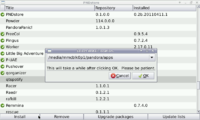I also don't see the need for the exact version number of the local/repo pnd. What benefits do you gain from knowing the exact numbers ? I still think one column with the graphical or textual info about the version relation (like repo is newer, local is newer, same version, not in the repo, etc.) would be suffice. The information about the exact version should be located in the info area.
Sorry for taking this out of order, but I wanted to respond to this point on its own. Actually I have two responses, one very general, the other very specific. I hope you'll appreciate both, but for the TL;DR version skip down a couple of paragraphs.

The approach you suggest might work, if you could always be sure that the latest version is the best for every purpose, but in software development its not uncommon for features to change between versions. Sometimes this means that a later version of a program no longer does what you want. In this case you'll want to make sure you have the specific version that *does* do what you want. If the version numbers aren't displayed how can you tell if its the right one?
An example of this is firefox. Someone on the firefox dev team had the bright idea that in firefox 4 they should remove the option to have a status bar at the bottom of the screen, opting to display status bar stuff in the right hand end of the location bar instead. Of course given the Pandora's screen size and the fact that there is a a lot of other stuff sharing the same horizontal space, this means that there is no longer enough room to display most URLs when you mouse over them. That makes the new version less useful to me. It wouldn't have been a problem had they kept the original feature, but noooo... Luckily for me, in this case there is an extension available that restores this functionality, but not every piece of software is so extensible.
More specifically, and perhaps more relevantly there are several cases where there are multiple versions of the same software with different application IDs. Take the Apple ][ PND for example. I downloaded it yesterday. Today I noticed that a new version had been released, but as far as the PNDstore was concerned it was a completely separate app. (and the original had been removed from the repo) If we were only using your relational method for version control, all the store would be able to tell me, is that there was one version in the repo and one installed, but since it had no way of knowing they were the same app, it would not be able to compare them and I would not be able to identify which was the newer version.
I guess I just look at things from another angle then. *wry smile*
Indeed we are seeing things from very different perspectives. If I browse a list of things which I don't know anything about it is faster for me if I don'thave to take my eyes from that list. Having an info area is a must but interrupts the "browse through the list" process. Because of that I came up with the second line per list Element idea. Having the first words of a pnds descriptions, gives me the possibility of deciding wether my eyes should wander to the info area to see more, or not.
AHA it comes down to shopping style!

So if I understand you correctly, you want to be able to window shop. Browse around until something catches your eye, then go in for a closer look if you see something you like. To my mind that works well only if specifics don't matter. If you are looking for the perfect compliment to your living room to display on your coffee table for example that would be the best approach.
On the other hand, I'm the type of person who normally only goes shopping when I want to get something specific. Say I'm working on for a project and I determine that I need a 2" bolt. When I go to the hardware store I really don't want to have to browse through a single bin containing all bolts looking for one that is 2" - I want to go to the bin labelled 2" bolts, and grab one.
For my intended usage, I'm afraid I would find your preferred layout quite cumbersome *wry smile*
Finding arguments for setting the location of the info area a certain "side" is rather hard, as it is matter of taste. The only one I can come up with is the afformentioned "we have more - not really used - horizontal space than vertical". So I think we can savely say the only good solution here would be to have it configurable. Quite nice to sit on the other side of the table for once - bringing up ideas, and someone else has to struggle to realize it

You are correct of course that it does come down to personal preference, For me the focus is on management of my PND files, and the more specifics I can see at a glance the more useful I will find it. Here's hoping Tempel can find a way to accommodate us both.

- Neelix


